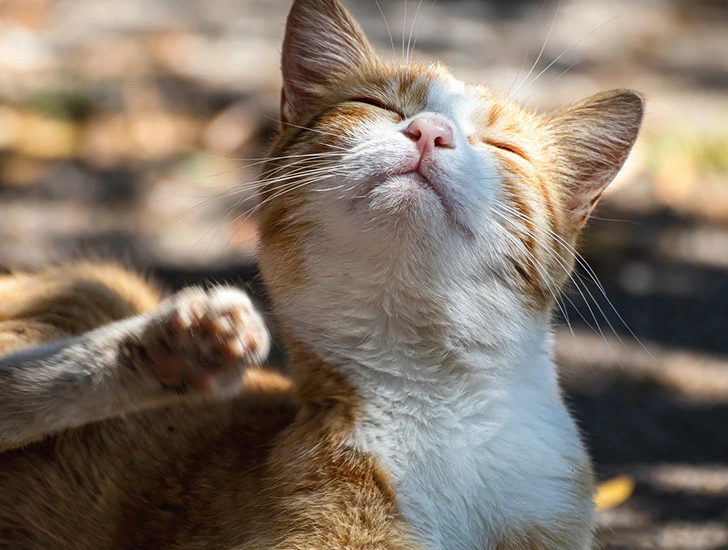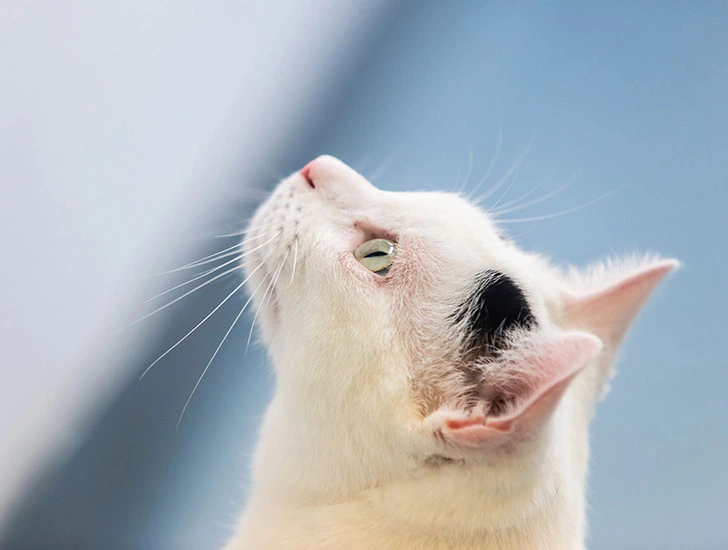Have you noticed your cat has been scratching or licking their skin a bit more than usual lately? Their skin could be irritated or it might be a sign of skin disease. Learn more about common cat skin problems, signs and treatments in this guide.
Being the largest organ in the body, a cat’s skin acts as a protective barrier against the outside world. It helps them maintain the right body temperature and keep their hair and claws healthy. Developing a skin condition can make your cat feel unwell and treatment should not be delayed.
Sometimes it’s easy to spot when your cat has a skin problem, at other times it can be more difficult to understand. Different health conditions can cause their skin to react similarly, and multiple skin issues can appear at the same time.
Your vet should be the first point of contact when you notice anything different about your cat’s skin.
When there is a skin problem, you may notice the following:

There can be a variety of reasons why your cat may experience skin disease. In most cases, it is caused by parasites, allergies or infections, and is often made worse through scratching the area. See below to find out more.
Both indoor and outdoor cats can pick up parasites, but the risk is higher for cats that venture outside. Parasites can live on a cat’s skin for a while and cause a wide range of symptoms.
The most common allergy in cats is an allergy to flea bites. You won’t often see the bite itself but will see either the skin’s allergic reaction to the bite, or your cat showing discomfort (hair loss, chewing on fur, or making the skin sore through overgrooming). In some cases, it can be hard to find any fleas at all, so not having obvious fleas does not rule out a flea allergy.
Like humans, cats can also be allergic to everyday items in their environment like pollens or house dust mites. Direct contact of the skin with an allergen, such as certain chemicals or detergents can cause ‘contact’ dermatitis.
Cats can also have intolerance or allergic reactions to certain ingredients within food, even foods they have previously eaten without a problem.
Bacterial infections in cats are normally the result of a bite, wound or underlying skin disease such as an allergy. Therefore, the signs may be more related to the underlying process but more severe, or there may be scabs, sores, or redness on the skin.
Ringworm is a common and highly contagious fungal infection of the surface of the skin, hair or nails. It’s not caused by a worm and it’s not always ring-shaped despite its name.
Ringworm can spread through contact with an infected animal, object or environment. It can cause itching (but not always), hair loss, redness, crusting and scaling of the skin.
Any cat might be affected, however, it is most often seen in young or very old cats, ill cats and those with an impaired immune system. Long-haired cats, such as Persian cats, are more at risk.
Cat hair loss, also known as alopecia, is when a cat loses hair and develops bald spots.
It’s not an uncommon problem in cats and rather than the fur falling out or not growing, in most cases the cat is removing the fur themselves via grooming or scratching. Cats can also be very secretive about this, and precise; sometimes forming baldness with very clear edges.
It can have a variety of possible causes, for example, skin diseases including allergies and ringworm can cause hair loss. Some cats experiencing stress, or pain in a particular area, may start overgrooming and pulling their fur.
If you notice small dark specks or bumps that won’t go away around your cat’s chin, it could be a sign of feline acne, better known as cat chin acne.
It’s still quite unclear why some cats develop this condition. Allergies may be the cause in some cats. Other underlying health conditions may also contribute, and secondary infection with bacteria can occur.
Although cat acne usually heals on its own, in some cases it might turn into a reoccurring issue or become more severe.
Cat acne treatments usually involve cleaning the area with medicated wipes and in severe cases, antibiotics might be used. Changing to ceramic food bowls and rinsing them well of any detergent is often advised. Any treatment should be started with guidance from your vet.
If you find your cat has a new lump or bump, you should know that a lot of things can cause cats to get lumps. Types of lumps can vary from insect bites or stings, abscesses and cysts to non-cancerous or cancerous tumours.
It’s important to note that any growths that do not go away for a long time, especially if they’re spreading or changing colour or shape, need to be examined by a vet without delay. Find out more about lumps and bumps on cats.
A skin ulcer is an open sore or wound that could show up anywhere on a cat’s body.
There are various ways your cat might develop an open sore. It can occur with injuries, especially for those that get into fights with other animals, but it can also come from insect bites. Cats with other underlying conditions or infections are also more prone to developing skin ulcers.
The appearance of skin ulcers can vary but generally they appear as round wounds with some discolouration which can become red and inflamed. Such wounds are very painful to cats and require careful wound treatment, along with an investigation of the underlying cause.
If you notice your cat has been licking or scratching a certain area more than usual and there is a wound, arrange an appointment with your vet as soon as possible.
While it may not be a common skin disease, similarly to humans, cats can also develop skin cancer due to abnormal growth of cells in the skin.
There are many types of skin cancer, however, in most cases, skin cancer in cats is caused by exposure to the sun.
White and even some coloured cats (those with white or pale ears and noses) are most at risk of harmful sun rays. Due to the lack of a pigment called melanin in their skin, they are more vulnerable to sun damage. Symptoms of exposure to too much sun usually start with hair loss around the ears, leading to scabbing and crusting and wounds that won’t heal. If continued or left untreated, sunburn can progress to skin cancer, for which surgery is often the most successful treatment. Read more information about cancer in cats.

It’s important for any skin conditions to be examined by your vet, so your cat can receive appropriate treatment as soon as possible.
When you take your cat to a vet, they might ask you some questions to learn a bit more about your cat’s history including any changes to their lifestyle, diet and other signs you have seen. They will examine them and may also select further tests to help pinpoint the possible causes.
Your cat may need a combination of treatments to manage the underlying condition together with additional treatment to relieve any itchiness, discomfort or secondary infections.
Your vet may recommend cat skin treatments, such as:
Some skin conditions cannot be cured but may be controlled through lifelong treatment.
It is advisable to avoid trying any homemade treatments at home.
Whether it’s a treatment oil or a supplement, some home remedies for cat skin problems which were not recommended by your vet could make the condition worse or not help with the healing. Skin ointments and creams designed for humans may be toxic for cats.
Due to the complexity of skin conditions and various treatments available, it’s always recommended to contact your vet as soon as you notice any signs of symptoms.
The way your cat’s skin and coat looks are good indicators of their general health. Normally, a healthy cat’s coat is smooth and shiny and the skin is not flaky or bumpy.
Prevention is always better than cure and while some skin disorders cannot be prevented they can be managed with appropriate care and treatments.
The following options may be helpful:
If your cat is looking in poorer condition and their coat looks thin, matted or there is flaky or thickened skin, this can be an indicator of underlying health conditions. Book an appointment with your vet so they can investigate this further.